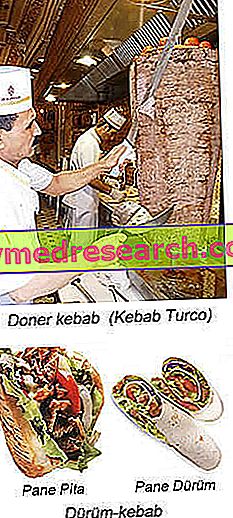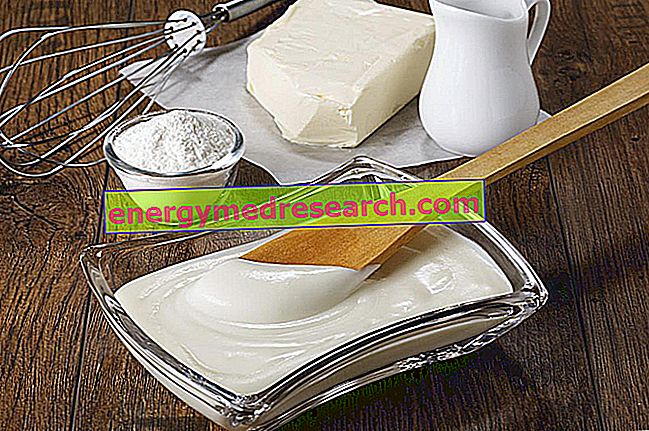Generality
Even if Kebab is a Turkish term *, in common language it is used to indicate a wide range of meat foods - packaged as a skewer, then skewered and cooked on the grill - originating in the Middle East and then spread throughout the Balkan area, in the Caucasus, in Europe, in central and southern Asia etc.

Due to the considerable heterogeneity of the kebabs proposed in the various areas of Italy and the rest of the world, it is very difficult to express a single nutritional evaluation of the food; however, by estimating the caloric intake of the different types of raw materials used and considering the cooking method, it is possible to state that the kebab, similar to our "grilled meat", is a highly energetic dish, rich in proteins, mainly fats saturated and cholesterol, characterized by the presence of toxic molecules (polycyclic aromatic hydrocarbons).
* The term "kebab" is the subject of various interpretations and linguistic distortions. While in the East the word kebab means all types of meat cooked on the fire, in English kebab means only the shish kebab (Turkish skewer); in many areas of Italy, instead, by ordering a kebab, a pita or Arabic type sandwich filled with grilled meat (called Doner kebab or Shawarma or Gyro ) will be served; this preparation is called dürüm kebab, from the name of the typical Turkish bread ( dürüm ) similar to Italian piadina and Mexican tortilla.
Beyond the various territorial interpretations, the "real" kebab is a dish consisting of skewers cooked on the grill, composed of various pieces of meat and coming from animals that are also very different (but always respecting the specific Middle Eastern religious prohibitions) . The beast traditionally most used in the formulation of the kebab is the ovine, in particular the lamb or the mutton; there is no shortage of goat kebabs, beef, chicken, pork and fish.
Currently, for most Western cultures, kebab is considered an ethnic dish perfectly integrated into the local culture. The word kebab probably derives from the terms "kabab - kababu - kbaba" which, in Arabic - Akkadian - Syriac, indicate "frying or burning". It seems that the kebab has very ancient roots (more than western fast-food); it is hypothesized that the first forms of kebab appeared between Greece and the Middle East several centuries before the birth of Christ. Some findings indicate that, in medieval times, this method of cooking constituted a fundamental survival expedient for Persian soldiers who stuck food directly on their own sword, cooked it on the fires and consumed it directly on the battlefield.
The kebab widespread in Italy - Doner kebab, Shawarma or Gyro?
The food typically distributed in Italy with the name of kebab is none other than the dürüm-kebab, or a sandwich of Turkish bread ( dürüm ), Arabic ( pita ) or Armenian (lavash) stuffed with Doner kebab (Turkish version); the same name is also improperly used for very similar carnea preparations but of different origins, such as the Shawarma (Arabic version) and the Gyro (Greek version). The misunderstanding probably stems from the fact that all three use the same cooking method; these "kebabs", in fact, use a vertical (usually electric) grid near to which, by means of a motorized instrument, the enormous meat spit turns on itself, cooking evenly on its outside. The cooked kebab is then thinly sliced and possibly kept warm in the metal plate located at the base of the instrument (or in a food warmer), before being served as a dish or for filling the famous sandwich. Doner kebab and its variants can also be an ingredient in pizza filling.
Many will wonder why the "kebabbaro" continues to slice the meat even when it has no orders in sight; in reality the answer is very simple. This cooking system is as banal as it is delicate; let the kebab continue to cook to the bitter end would cause two drawbacks: 1. The drying of the external meat; 2. Failure to cook the internal one. This means that, once the superficial layer is cooked, the process is interrupted or you continue to cook after slicing the outer kebab. Another methodological problem is also present; cooked and sliced meat, if not readily served, tends to dehydrate excessively losing its organoleptic and taste characteristics. For this reason, at the base or next to the kebab, there is always a large metal plate (or alternatively a food warmer) filled with vegetable oil in which to drown the slices of meat until the time of service. This is the fundamental reason why the kebab also falls into the category of high-calorie fast food.
Hygienic aspects
Referring to Doner kebab, Shawarma and Gyro, it is essential to make some observations of hygienic and nutritional interest. Without citing any brand, many kebabs have been (and still are) subjected to various quality and composition checks. The results are rather worrying as there are constantly episodes of food fraud and micro-biological contamination.
It seems that the compositional analysis of these huge kebabs reveals certain "more or less meat" ingredients not present on the specific food label. At best, the foreign element is made up of other types of meat (often offal of various kinds emerge), but there is no lack of reports due to the presence of cartilage, bones, teeth and eyes.
We also remember that the Doner kebabs are made up of pieces of raw meat stacked on each other and then frozen; this feature requires a certain care in maintaining the cold chain since, unlike any WHOLE block of meat, the kebab uses a larger surface area useful for bacterial proliferation. This means that any interruption of the cold chain or unsuitable preservation of the meat (due to the negligence of traders and couriers) could easily create an environment suitable for bacterial culture growth (especially of staphylococcus and coliforms) as a potential cause of toxinfections even serious food.
Moreover, despite the large kebabs being placed on the rotisserie still frozen (which does not facilitate cooking but shortens consumption times very much), it is essential to remember that it takes several days to consume a large kebab. In my opinion, this is a rather risky practice.
Last but not least, the level of hygiene guaranteed by the operator; in addition to the kebab in any form of fast-food (especially street vending), it is always essential to evaluate the cleanliness of the worktops, cooking and, why not, even refrigerators (peeking at the time of opening and closing). Citing the kebabs, I invite all readers to evaluate (before anything else) the degree of cleanliness of the dish located at the base of the large skewer (where the meat is collected) and, of course, the cutting boards as well as the tools (knives, pliers), razors etc). In the event that a certain hygienic "carelessness" was evident, I strongly suggest that you give up the coveted meal without delay.
Nutritional characteristics
As anticipated, it is not easy to make a nutritional evaluation of such heterogeneous preparations as kebabs; taking durum kebab (sandwich) as a reference, it is possible to state that it is a high-calorie food rich in fat (saturated with meat and, at best, unsaturated with which it is kept tender after cutting). Do not miss a good dose of cholesterol while the fibers are more or less lacking depending on the addition or not of raw vegetables and cooked in the filling. Furthermore, although pita or Arabic bread is NOT a particularly elaborate or lipid-rich derivative of cereals, it nevertheless contains high percentages of complex carbohydrates, which contribute to further raising the energy density of kebabs. Proteins have a high biological value but, like the vitamin and salt content, do not justify the frequent consumption of the product.
The kebab is therefore a food not suitable for the diet against overweight and for hypercholesterolemia. The relative medium portion advisable does not exist, since the kebab does not have a single shape and the padding varies according to the "hand" of the operator. We recommend sporadic and non-systematic consumption.



